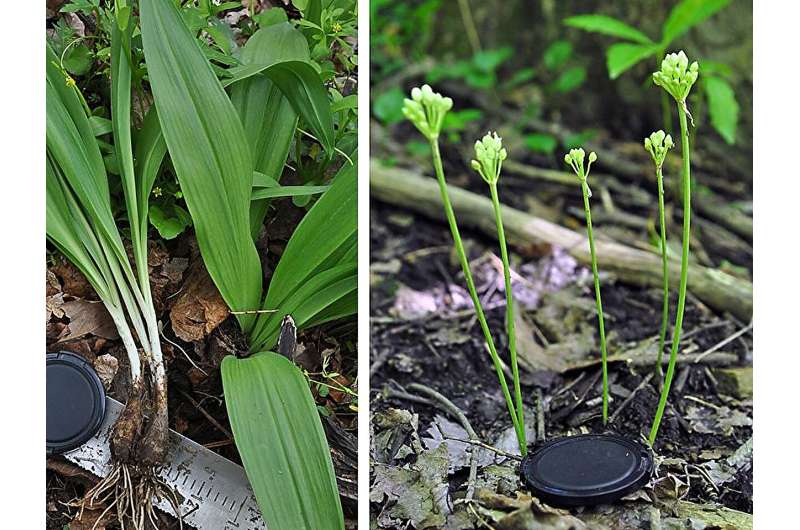This article has been reviewed according to Science X's editorial process and policies. Editors have highlighted the following attributes while ensuring the content's credibility:
fact-checked
peer-reviewed publication
trusted source
proofread
Second species of ramp, or wild leek, documented in Pennsylvania

The presence of a second species of ramp, Allium burdickii—commonly known as narrow-leaved wild leek—has been documented in southwest Pennsylvania by a team of Penn State researchers in a new study. This plant species never before has been documented in the state, and the researchers suggest the discovery shows a need to protect remaining populations of the plant.
The more common and well-known broader-leafed ramp species, Allium tricoccum, is widespread in the state and often collected. Eaten for thousands of years by Native Americans, ramps are valued for their strong garlic-like aroma and onion-like flavor. More recently, they have become popular among foodies and restaurant chefs, leading to an increased demand by urban consumers.
Allium burdickii likely has been in Pennsylvania a long time, according to team leader Eric Burkhart, associate teaching professor in the Department of Ecosystem Science and Management. His research group in the College of Agricultural Sciences has been studying the distribution and abundance of forest herbs such as ramps, goldenseal and ginseng for nearly two decades.
"We think at one time, there was probably a much more widespread and perhaps contiguous population of the slow-growing perennial plant that occurred throughout western Pennsylvania into the Midwest," he said. "But now, A. burdickii seems to be found only in isolated populations in increasingly urban areas outside Pittsburgh. We are working to figure out areas where it occurs so that hopefully we can conserve what's left."
Because Allium burdickii has thinner leaves, grows in slighter dryer locations and flowers earlier than Allium tricoccum, scientists and perhaps most collectors just missed it, Burkhart explained.
"From a conservation standpoint, because we're finding A. burdickii in urban areas around Pittsburgh to date, the populations appear to be relatively small and localized—and they are vulnerable," said Burkhart, who is director of the Appalachian Botany and Ethnobotany Program at the Penn State Shaver's Creek Environmental Center. "Because of development in the region, and the high demand for ramps, we need to educate the public about the need to recognize and conserve them."
Researcher Cassie Stark, who spearheaded the study as a master's degree student, studied four populations each of Allium tricoccum and Allium burdickii in southwestern Pennsylvania, and compared and contrasted the habitats where they were found. She documented the soil fertility and moisture and site characteristics, such as topography, associated with sites where each species of ramp grew. Also, she recorded the presence of other plants growing with the ramps.
In findings published July 26 in the Natural Areas Journal, the researchers reported that Allium tricoccum is associated with north-facing slopes and higher soil moisture content throughout the growing season, whereas Allium burdickii was found on a variety of facing slopes. Soil pH and nutrient content were greater at Allium burdickii sites than Alliumtricoccum sites, suggesting the former may rely more heavily on nutrients such as calcium.
More information: Cassie J. Stark et al, Two Ramp Taxa, Allium tricoccum and A. burdickii, Differ in Abiotic Habitat Characteristics and Floristic Associates in Pennsylvania, Natural Areas Journal (2023). DOI: 10.3375/22-30
Journal information: Natural Areas Journal
Provided by Pennsylvania State University





















